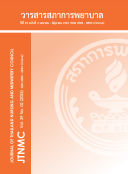Development of the Nursing Practice Guidelines for Pain Management among Cancer Patients in Maharaj Nakorn Chiang Mai Hospital
DOI:
https://doi.org/10.60099/jtnmc.v39i02.268146Keywords:
pain, nursing practice guideline, guideline development, cancer patientsAbstract
Introduction Pain is a significant problem experienced by cancer patients, affecting both the patients and their caregivers. Evidence-based clinical nursing guidelines are necessary for effective pain management.
Objective To develop nursing practice guidelines (CNPGs) for pain management in cancer patients.
Design Operational research
Methodology The development of the Nursing Practice Guidelines based on the ADAPTE Collaboration (version 2.0) consisted of three distinct phases: 1) the set up phase, 2) the adaptation phase, and 3) the finalization phase. Participants comprised three groups: 1) five healthcare professionals as the guideline development team, 2) three cancer patients in a private ward at Maharaj Nakorn Chiang Mai Hospital, who received care according to the guidelines, and 3) four healthcare personnel who implemented the Clinical Nursing Practice Guidelines (CNPGs) and adhered to all recommendations. The research instruments included 1) a guideline screening tool, 2) the Thai version of the Appraisal of the Guideline for Research & Evaluation II (AGREE II), 3) a cancer patient screening form, and 4) a clinical outcome and process evaluation form. These instruments were quality-checked before use. Data were analyzed using descriptive statistics, including frequency and percentage.
Results The CNPGs comprised five key components: 1) protecting patient rights and ethics, 2) conducting pain assessment, 3) implementing pain management, 4) educating patients on pain self-management, and 5) monitoring adherence to the CNPGs and ensuring continuous quality improvement. Experts evaluated the quality of these guidelines, with all AGREE II components scoring above 80%, indicating their clinical appropriateness. The patient handbooks on pain self-management were also considered appropriate, providing comprehensive and easy-to-understand information. The guidelines were considered feasible, as patients reported pain relief each time pain occurred (21 times). Patient satisfaction with the care provided using these guidelines was highest, and healthcare personnel reported satisfaction to highest satisfaction with their use.
Recommendation This study recommends implementing nursing guidelines for managing pain among cancer patients in clinical settings. Further research should focus on evaluating the effectiveness of these guidelines, considering both clinical outcomes, and process evaluation.
Downloads
References
Breivik H, Borchgrevink PC, Allen SM, Rosseland LA, Romundstad L, Breivik Hals EK, et al. Assessment of pain. BJA. 2008;101(1):17-24. https://doi.org/10.1093/bja/aen103
Jara C, Del Barco S, Grávalos C, Hoyos S, Hernández B, Muñoz M, et al. SEOM clinical guideline for treatment of cancer pain (2017). Clin Transl Oncol. 2017;20(1):97-107. https://doi.org/10.1007/s12094-017-1791-2 PMID: 29127593
Cancer Research UK. Causes and types of cancer pain. 2024. Available from: https://www.cancerresearchuk.org/about-cancer/coping/physically/cancer-andpain-control/causes-and-types
Russo MM, Sundaramurthi T. An overview of cancer pain: epidemiology and pathophysiology. Semin Oncol Nurs. 2019;35(3):223-8. https://www.doi:10.1016/j.soncn.2019.04.002 PMID: 31085106
Pichayapanich P, Chayangsu C. Management of cancer pain for internist. Medical Journal of Sisaket Surin Buriram Hospitals. 2021;36(2):475-84. Available from: https://he02.tci-thaijo.org/index.php/MJSSBH/article/view/252946/172037 (in Thai)
Swarm RA, Paice JA, Anghelescu DL, Are M, Bruce JY, Buga S, et al. Adult cancer pain, version 3.2019, NCCN clinical practice guidelines in oncology. J Natl Compr Canc Netw. 2019;17(8):977-1077. https://doi.org/10.6004/jnccn.2019.0038 PMID: 31390582
van Veldhoven, LM, Novy DM. Psychosocial assessment and treatment for patients with cancer pain. In: Gulati A, Puttanniah V, Bruel B, Rosenberg W, Hung J. editors. Essentials of interventional cancer pain management. Cham (Switzerland): Springer; 2019. p. 451-62. Available from: https://doi.org/10.1007/978-3-319-99684-4_49
Banthip K, Pechratchatachat A. Spiritual nursing dimension for chronically patient in community. Songkhla: PC Prospect; 2016.
Chi NC, Demiris G. Family caregivers’ pain management in end-of-life care: a systematic review. Am J Hosp Palliat Care. 2017;34(5):470-85. https://doi.org/10.1177/1049909116637359 PMID: 26975303
National Cancer Institute. Coping with cancer. 2021. Available from: https://www.cancer.gov/about-cancer/coping
World Health Organization. Cancer pain relief: with a guide to opioid availability. 2nd ed. Geneva: World Health Organization; 1996.
Taiwong A, Tilakarayasrup S, Srichunchai J, Jantasin B, Relachati C, Kakarndee A, et al. Innovative development for the assessment and management of pain using the evidence based practice. Mahasarakham Hospital Journal. 2018;15(1):167-75. Available from: https://he02.tci-thaijo.org/index.php/MKHJ/article/view/195200/135697 (in Thai)
Thongchai C. Clinical practice guidelines development. The Thai Journal of Nursing Council. 2012;20(2): 63-76. Available from: https://he02.tci-thaijo.org/index.php/TJONC/article/view/2245/1883 (in Thai)
The ADAPTE Collaboration. The ADAPTE Process: resource toolkit for guideline adaptation, version 2.0. Hamilton (Canada): Guideline International Network; 2010. Available from: https://g-i-n.net/wp-content/uploads/2021/03/ADAPTE-Resource-toolkit-March-2010.pdf
McCaffery M, Beebe A. Pain: clinical manual for nursing practice. Maryland: Mosby; 1989.
Teasdale G, Jennett B. Assessment of coma and impaired consciousness. A practical scale. Lancet. 1974;2(7872):81-4. https://doi.org/10.1016/s0140-6736(74)91639-0 PMID: 4136544
Maharaj Nakorn Chaing Mai Hospital, Nursing Department, Palliative care committee. Palliative performance scale for adult Suandok (PPS-Adult Suandok); 2008. Available from: http://hsmi2.psu.ac.th/food/upload/forum/7_Suandok_s_Palliative_care_model_5.60.pdf (in Thai)
National Health and Medical Research Council. How to put the evidence into practice: implementation and dissemination strategies. Canberra (Australia): Biotext; 2000. Available from: https://www.nhmrc.gov.au/sites/default/files/2018-03/how-to-put-the-evidence-into-practice-implementation-and-dissemination.pdf
Lasuka D. Clinical practice guidelines adaptation: concept and process. Nursing Journal. 2013;40(Suppl 2): 97-104. Available from: https://he02.tci-thaijo.org/index.php/cmunursing/article/view/19087/16790 (in Thai)
Ball CM, Phillips RS, editors. Acute medicine: evidencebased on-call. Edinburgh (United Kingdom): Churchill Livingstone; 2001.
Ministry of Public Health, Department of Medical Services, Institute of Medical Research & Technology Assessment. Appraisal of guidelines for research & evaluation II: AGREE II (Thai version). Nonthaburi: Institute of Medical Research & Technology Assessment; 2013. Available from: http://www.imrta.dms.moph.go.th/imrta/images/AGREE%20ok%20for%20e-book.pdf (in Thai)
Cohen J. Weighed kappa: nominal scale agreement with provision for scaled disagreement or partial credit. Psychol Bull. 1968;7(4):213–20. https://doi.org/10.1037/h0026256 PMID: 19673146
Joint Commission International. Joint Commission International Accreditation Standards for hospitals. 7th ed. Illinois: Oakbrook Terrace; 2021.
Chang VT, Hwang SS, Feuerman M. Validation of the Edmonton Symptom Assessment Scale. Cancer. 2000;88(9):2164-71. https://doi.org/10.1002/(sici)1097-0142(20000501)88:9%3C2164::aid-cncr24%3E3.0.co;2-5 PMID: 10813730
Minello C, George B, Allano G, Maindet C, Burnod A, Lemaire A. Assessing cancer pain- the first step toward improving patient’s quality of life. Supportive Care in Cancer. 2019;27(8):3095-3104. https://link.springer.com/article/10.1007/s00520-019-04825-x
Joanna Briggs Institute. Joanna Briggs Institute reviewers, manual: 2008 edition. Adelaide (Australia): Joanna Briggs Institute; 2008.
Downloads
Published
How to Cite
Issue
Section
License
Copyright (c) 2024 The Journal of Thailand Nursing and Midwifery Council

This work is licensed under a Creative Commons Attribution-NonCommercial-NoDerivatives 4.0 International License.








